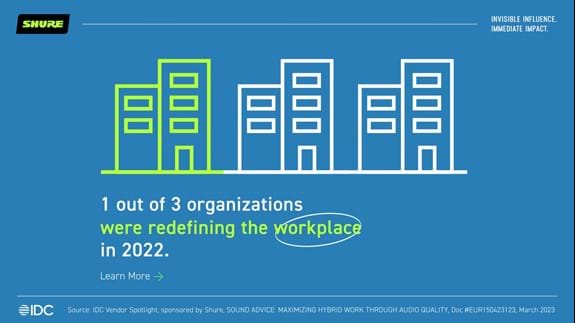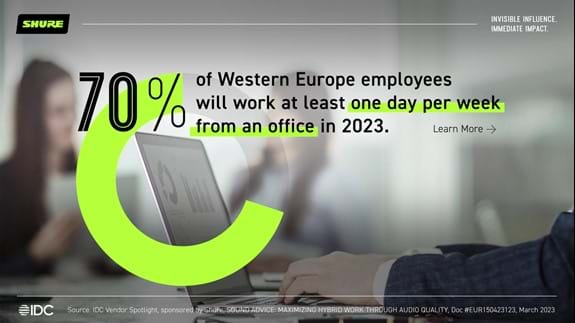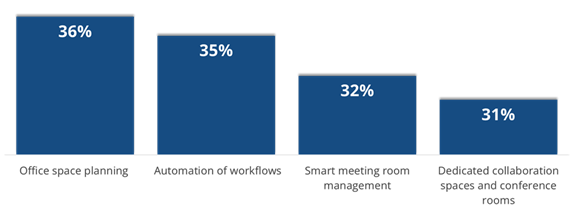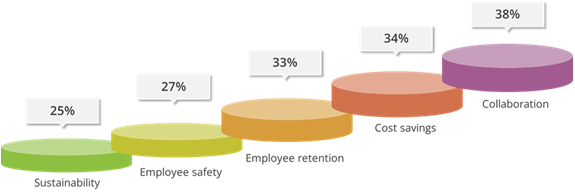
Driving the future of work: Hybrid the new normal
As the future of work continues to evolve, so does the need for office spaces that can adapt to these changing demands. As a result gone are the days whereby offices need to accommodate row upon row of desks for employees to sit down to work for set, pre-determined hours; instead organizations need to redefine and redesign the office space as “community hubs” with collaboration and breakout spaces making the environment flexible enough to allow different spaces to be used for different purposes according to people’s needs, and the way in which we work, collaborate and communicate.
Considering the work paradigm shift of the past three years, the workplace has not kept pace. IDC data suggests that many offices designed in pre-pandemic times are not fit for hybrid work.
Is your office a relic of pre-pandemic times?
Whilst the buildings we go to every day haven’t changed, the tools we use to get work done have changed significantly.
Old-style offices were designed for privacy and isolation, and open-plan work areas full of typewriters and adding machines were designed for efficient flow of paperwork. Now pretty much any space from the desk to the conference room is used for any purpose.
Technology has a crucial role to play in making the environment flexible enough to allow different spaces to be used for different purposes according to people’s needs, whether that involves work, wellbeing, or upskilling.

Combining audio communication patterns with physical space can increase the probability of interactions that lead to innovation and productivity
Office space planning is the most important office tech investments. The whole user journey of employees around the workplace now needs to be reimagined to place collaboration at the center, with the re-designed offices of tomorrow including highly networked, shared, multipurpose spaces that redefine boundaries between companies and improve everyone’s performance.
At the same time departments such as HR, IT, and facilities management will transform from support functions to facilitators. If companies change their spaces to reflect how people work, performance improvement will follow.

36% of organizations said that office space planning was the most important office tech investment.
Need to focus on communication and collaboration technology
IDC believes a much more sensible approach is one that focuses on creating a modern and attractive workspace that makes staff naturally gravitate to it, creating a thriving social environment.
Although it may seem counter-intuitive, several companies are encouraging workers to interact with their colleagues more and spend less time in front of their screens.
Better communication within your organization means employees get the chance to gain a better understanding of the company, how it’s performing, as well as the roles, responsibilities, and skills of the colleagues around them. When staff learn more about the people they work with, they’re better equipped to utilize each other’s strengths, which in turn helps to boost productivity and improve the overall attitude in the office.
According to the latest IDC Future of Work Survey, the main reasons for going to the office have clearly shifted in the past three years, with a much stronger focus on onsite collaboration and training. 38% of organizations said collaboration is a key driver for office redesign, together with cost savings and employee retention.
38% of organizations said collaboration is a key driver for office redesign.

The challenge
If collaboration is now at the center of workplace strategy, organizations need to provide the necessary tools to enable the best possible teamwork in the office and facilitate best-in-class interactions between in-office workers, remote employees, and customers.
IDC research clearly shows that the equipment used in most companies is not optimal.
Even though hybrid meetings are a normal part of everyday workflows, team members often struggle to achieve a satisfying conversation flow that enables all members to equally contribute to discussions. Because of this, remote attendees rarely lead discussions, and are often sidelined and do not contribute fully. This can lead to delayed decision making and ultimately a loss of productivity.
The current challenges faced during hybrid meetings are increasing the demand for tools that ensure meeting equity and that ultimately improve productivity.
IDC sees an important business case for investments in workplace communication and collaboration technology.

A survey by NTT Data Institute found that only 19% of people said the quality of online meetings improved significantly with better image quality, but the figure for improved audio quality was 81%
Technology integration will be imperative
With workers returning to the office in different ways and on different schedules, choosing the right tools and technology to ensure your workforce can be their most productive – wherever they are -- is vital.
AV and UC solutions play a large part in providing a reliable, seamless experience for employee collaboration. A fully-supported videoconferencing experience needs a compute platform, some form of control, and audio and video components, and the best full-room solutions are ones that have been tested and proven to work well together. Conferencing platforms like Microsoft Teams and Zoom have rigorous certification programs, so look for certified products that boast technology partnerships with other UC brands for the best, most reliable experience.
The next element to consider when choosing the right technology is the size and needed flexibility of the space. For example, audio equipment that will be perfect for a small conference room, will not necessarily be a great solution in a large meeting room. Alternatively, products ideal for your larger conference rooms are likely overkill in smaller meeting or huddle rooms. The complexity of integration and cost would be unnecessary to accomplish the task of audio coverage and pick-up in the smaller room. This budgetary overkill can be avoided by working with a qualified professional and considering the space and its needs before you decide on any final design solution.
The recipe for good audio relies on three main ingredients:
1 : CLARITY
2 : CONSISTENCY
3 : COMPLETENESS
Speech needs to sound clear, natural, and intelligible so that words are easy to understand.
Speech levels need to be the same for everyone in the room.
Audio capture must extend to every seat so that no one is left out of the conversation.
State-of-the-art array microphones for conference rooms must be able to overcome the challenges of modern meeting rooms and deliver clear, consistent, and complete audio.
Array microphones like Shure’s Microflex® Advance™ MXA920 for ceilings, or MXA710 for both walls and ceilings, are a great choice for reliable sound pickup from a device that does not need to be moved or touched. Coupled with Shure’s IntelliMix® digital signal processing, consistent audio quality can be enhanced in all types of acoustic environments.
Great audio makes meetings more tolerable and more effective – not just for those in the room, but those joining remotely. By ensuring a fully satisfying experience for every participant, the hybrid workplace can enable all employees to contribute their best work.
Regardless, Plan Ahead
Given the importance of collaboration for overall employee experience and the impact that audio can have in meetings, reconfiguring collaboration spaces to build the right employee experience is now critical. Failure to do so can impact employee experience, lead to staff burnout, and create missed opportunities.
IDC believes that investments to enhance hybrid meetings through audio quality can lead to tangible business outcomes.
Having a plan for what equipment you’ll use, where it will go, and who will be using it, will ensure that everything runs as smoothly as possible, once the new products are in place.
Source: IDC Vendor Spotlight, sponsored by Shure, SOUND ADVICE: MAXIMIZING HYBRID WORK THROUGH AUDIO QUALITY, Doc #EUR150423123, March 2023


Related Posts
Part 2: Sound of Satisfaction: How High-Quality Audio Enhances Employee Experience
Unleash employee satisfaction with high-quality audio. Enhance productivity, engagement, and workplace happiness through superior sound technology.
Circle of Frustration Video
Optimize productivity and morale by investing in quality audio solutions, enhancing communication, and breaking frustration cycles for both in-office and remote teams.